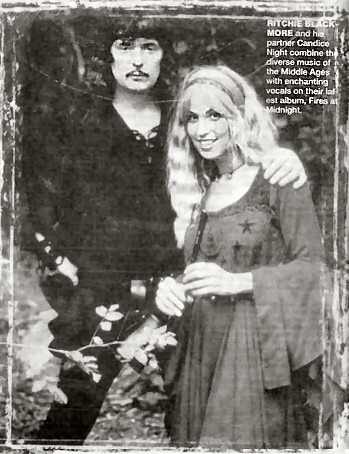|
Blackmore's Night Enchanting Midnight The times they are a-changin' for Ritchie Blackmore's search for the perfect music muse.  One could say said search began long before Blackmore etched his hard-rock stamp with the likes of Deep Purple and Rainbow. As a Middlesex, England, adolescent, Blackmore began touring Europe with some of rock'n'roll's pioneers in the 1950's-Gene Vincent, Chuck Berry and Jerry Lee Lewis.
"I was backing Jerry Lee Lewis when I was 18, and we went to Germany for the first time. I really loved the way they played hard and worked hard." Blackmore says in on exclusive phone interview with the Sun. "And I took to that Teutonic way of life. It almost seemed to me like that was my real home. Although I was English I could relate more to the German people."
One could say said search began long before Blackmore etched his hard-rock stamp with the likes of Deep Purple and Rainbow. As a Middlesex, England, adolescent, Blackmore began touring Europe with some of rock'n'roll's pioneers in the 1950's-Gene Vincent, Chuck Berry and Jerry Lee Lewis.
"I was backing Jerry Lee Lewis when I was 18, and we went to Germany for the first time. I really loved the way they played hard and worked hard." Blackmore says in on exclusive phone interview with the Sun. "And I took to that Teutonic way of life. It almost seemed to me like that was my real home. Although I was English I could relate more to the German people."Blackmore's present-day partner has a much more insightful look at what his roots are, "Grey," dead-pans the bubbly Candice Night, prompting the usually serious Blackmore to softly reply "Going grey, yes." Fascinating Mix The humerous exchange comes courtesy of promoting Fires At Midnight, the third album from Blackmore's Night, due in stores Tuesday. As the name implies, Blackmore's Night is the joining of forces between middle-ager Blackmore - Who translates the diverse music of the Middle Ages using guitars, strings and a variety of Rennaissance-era instrumenty - and the enchanting voice of Night. What results is a facnating mix of rock, folk, 16th century music and an homage to the music of the Rennaissance. A 180-degree turn from, say, Smoke On The Water. Then again, after years of endlessly churning that riff for Deep Purple and various others With Rainbow, one could hardly contest Blackmore was in need of a change.That's not even getting into having to deal with a clash of band members' egos and oft-reported cases of Blackmore having a temperamental demeanour and perfectionist ways. "I've been in bands where there a lot of limitations." Blackmore says calmly. "They won't do certain types of music because they don't think it reflects their kind of style, and I think you could get bogged down in that." Artistic freedom Of Blackmore's Night, he lightens UP: "In this little setup, we can do anything that pleases us. Like doing, for instance, (Bob Dylan's) The Times They Are A-Changin' (off the new album), it's a great feeling to be able to say, 'We like that song, let's do it.'" Much of Blackmore s balanced state of mind these days has to do with Night, a former New York disc jockey who first encountered Blackmore in me early 1990s. "Travestite bar, wasn't it" Blackmore says to Night before her quick comeback "That's where I found you, yeah." But seriously... "Ritchie would come into town with Deep Purple and challenge whoever was around in our radio station to a soccer game." Night says cheerfully. "A lot of the deejays around were very used to pressing buttons but not accustomed to getting out on to a field and being athletic. So of course, Ritchie beat us mercilessly and I had to go over with my tail between my legs and congratulate him. "We found out that we had so many things in common - emotionally, spiritually and musically. And I haven't been able to get rid of him since." Night eventually went on the road with Blackmore during a Deep Purple tour in 1993 before the guitarist quit and formed Ritchie Blackmore's Rainbow a year later, with Night brought in as backup vocalist and contributing lyrics. "The funny thing is Ritchie and I were writing our music for what would become Shadow Of The Moon (the '97 debut from Blackmore's Night). We didn't know we were going to create an album, we just having fun writing and playing as a side thing just for our friends at parties." Shadow of The Moon would become something of a success story staying on the German album charts for 17 weeks and going gold in Japan. The release of '99's Under A Violet Moon went to No 20 in Germany and No. 12 in the Japanese Billboard charts, and the band embarked on another tour, performing in churches, theatres, opera houses and castles. A very mystical approach to take for live performances? "The song Fires At Midnight ia a very dark mystical kind of tune." Blackmore explains."It was originally a religious song from the medieval period. And I asked Candice, "What do you think this represents?" We both agreed it had a kind of witchcraft thing going on, all these silhouette figures around the fire. © Ian Nathanson, Ottawa Sun, 15 July 2001 |